
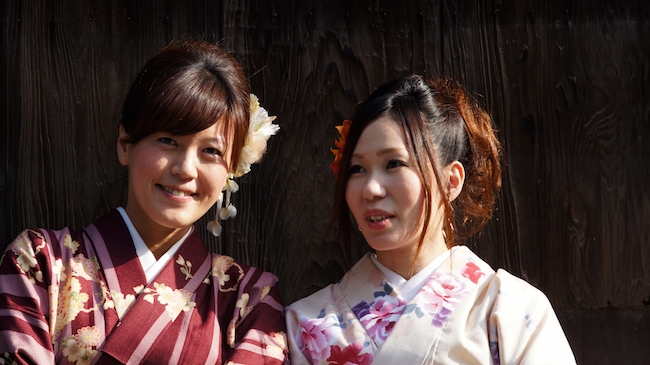
Replay: Craig Marshall offers his insights after two weeks shooting in Japan using his extremely portable home-brew set-up.
I've just returned from Japan where I spent two weeks shooting a promotional video on Kyoto for a Taiwanese client. During my stay, I read Part III of Roland Denning's excellent Red Shark article: 'How to test cameras' - 'Test them in the real world!' and don’t forget Barry Braverman's recent account of shooting at night on the streets of Paris with the Sony FS7. Given my recent experience in Kyoto, both these articles struck a chord so if you'll bear with me, I'll quote some brief segments then embed my own thoughts and reflections on their topics.
I generally shoot independently, without a crew as such, so the ability to move quickly is an essential element, with only the basic necessities to hand. Kyoto, the very beautiful and former ancient Japanese Capital is a real Mecca for local and International photographers and video crews alike. The City has a very strong French influence now and has been often noted as the 'Paris of the East'. The historic Sanjo Bridge at dusk is a magnet for anybody who feels compelled to capture the late afternoon mood as the riverside cafes prepare for the evening throng. On any night, you'll find Japanese camera crews setting up on the Bridge with their bulky (Sony) HDCAM outfits, complete with their 'crew of thousands'. There's usually one guy wandering about with a hooded monitor so his producer/director can check the pictures shot by their lowly camera guy! Alongside the Japanese, there's the North American crews and still photographers with their predominantly Canon DSLRs, Asian photographers with their Nikons and let's not forget the European tourists with their smart phones clipped onto selfie sticks! Camera stores used to stock telescopic tripods by the dozen. Now its telescopic selfie sticks!
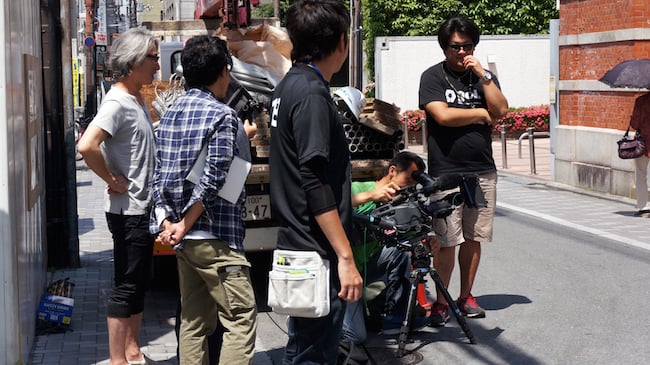
A typical Japanese video unit setting up on Sanjo Dori, complete with their ‘crew of thousands’!
I shot my Kyoto programme in HD at 25fps which is unusual for me as I'm still a big fan of 50i and 50p frame rates because of their superior motion interpolation, but on this shoot I predominantly went for static compositions capturing movement within the frame. My camera for this highly mobile shoot was an older Sony mirrorless E-Mount 'Super 35' hybrid camcorder coupled to an Atomos Ninja 'Star' ProRes HDMI recorder, a Metabones Speed Booster, plus a nice selection of classic Carl Zeiss Full Frame prime lenses. Although the Ninja Star will perform a 50i 'pull down' to 25p, my prior camera tests revealed that the 25p/ProRes HQ combo produced video images with the highest possible picture quality.
Over the years, I have been fortunate enough to own and operate some of the world's best broadcast ENG zoom lenses from Canon and Fujinon for 2/3" cameras but these are rare and expensive for Super 35 format sensors so today, I stick with primes. Over the years, I've gradually assembled a comprehensive collection of the 'Contax' series of Zeiss manual primes from the '80s and '90s. Apart from their optical quality, their appeal is that they feature 'low contrast' glass and the same T* coatings as their legendary CP2 cinema cousins. That is, the Contax series were designed at the time for professional stills photographers who liked to manipulate their images in the darkroom after a shoot just as film makers do today using software to grade their films in post.
The Contax 35mm, full frame 'stills' lenses will handle a very wide range of lighting conditions with ease and their video pictures 'grade' particularly well, unlike some modern lenses which, in my opinion, often result in sharp but overly high contrast images. The Contax series is lauded by owners of RED cameras too as they cover the entire 8K Dragon sensor but on a Super 35 camera, they are best mated with the Metabones Speed Booster which almost completely restores their Full Frame FOV, increases MTF and corrects for any potential aberrations caused by the low-pass/infrared/sensor cover glass filter pack which can be an issue when using older ‘film’ lenses for digital acquisition. With all the talk about cameras these days, people tend to forget the effect a lens has on a picture.
As I've written before, one of the reasons why pictures from the Arri Alexa always look so good is that it is generally hired and operated by people who know how to light a scene and it's usually mated to some of the world's most expensive glass.
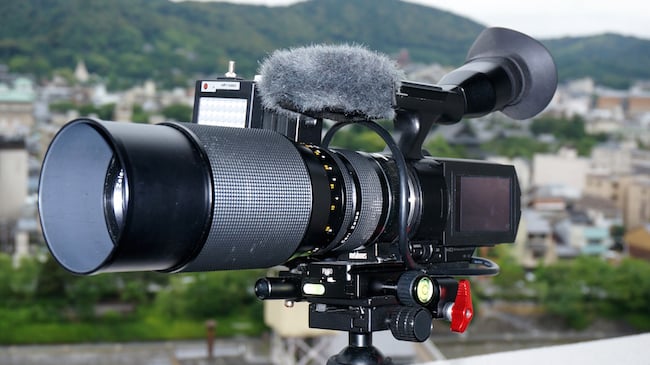
Zeiss 180mm plus Mutar 2x gives 360mm at only f2.8 with the Speed Booster on the Super 35 camcorder
My 'home brew' camera amalgam is certainly not in the Alexa or FS7 class but it doesn't need to be because it perfectly suits the sort of work I mostly do.
Roland asked: "Even the quantifiable aspects (of cameras) have subjective elements to them — one camera may claim higher sensitivity but may be no better than a lower spec camera with the gain turned up. When does picture noise become unacceptable? And whatever the quoted dynamic range, what do the pictures actually look like in high contrast situations? Does the viewfinder give you any idea of what the pictures really look like?”
To answer this, I'll give a recent example: a Korean crew I met on the Sanjo Bridge had one of the more modern rigs I saw in Kyoto. It consisted of a Sony A7s mirrorless full frame camera set in a heavily machined 'cage' housing mounted on top of one of the heaviest fluid tripods I've seen and to cap it off, they had an Atomos 'Shogun' 4K recorder perched alarmingly on top of the whole structure. They were shooting a timelapse sequence of still images at the time so there was plenty of opportunity to talk about cameras, which we did.
The Koreans raved about the quality of the 4K images they had captured with the A7s/Shogun combo and the ones they showed me certainly looked fantastic on the ProRes recorder's big monitor but after examining my diminutive setup, they seemed stunned at the excellent low light sensitivity my camera exhibited there and commented words to the effect: "you know, that's a really great setup and after lugging all this gear around Japan for two weeks, we really envy your mobility!"
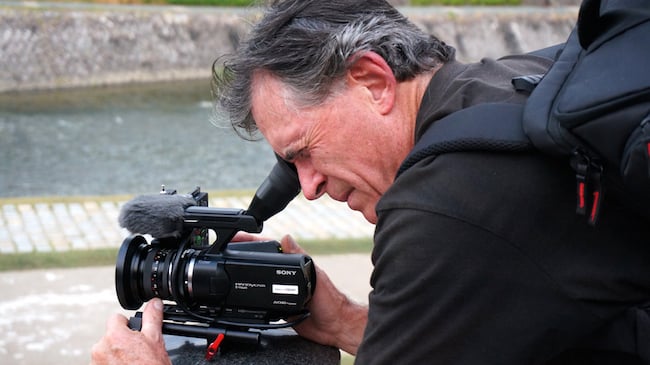
Midnight Special! Diminutive and super sharp Zeiss 50mm f/1.7 gives f/1.2 at the sensor with the Speed Booster attached
Of course, what they may not have realised was that with my diminutive Zeiss 50mm F1.7 lens fitted, I can shoot sharp HD video or RAW stills with the iris set wide open. The 'slower' Zeiss 50mm is as sharp as a tack wide open at f1.7 unlike its more expensive brother, the 50mm/F1.4. With the Speed Booster performing its optical light boosting thing and restoring the full frame lens' original field of view on to the Super 35 sensor, I can achieve a remarkably good 'low light' sensitivity of F1.2. Add into the mix some additional Gain coupled with the 4:2:2 colour space achieved by the ProRes HDMI recorder and the resultant HD pictures are more than acceptable for a three year old video camera.
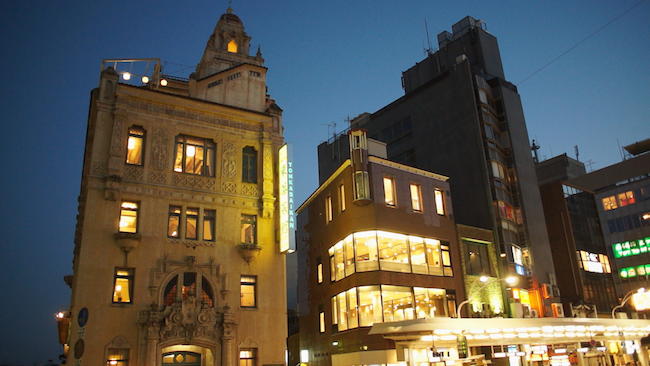
This ProRes 4:2:2 frame grab is with 20dB of Gain applied but even so, the Zeiss 25mm F2.8 competently handles highlight flare
One problem faced when shooting on the streets at night is Dynamic Range. Street lights are very bright and the shadows are very dark. The human eye can easily differentiate between the two extremes but cameras find it very difficult. Modern imaging devices are now quoting truly remarkable DR figures but I have no idea what the DR of my camera is, nor do I really care. What I do know, is that I need to be careful not to burn out too many highlights and I need a viewfinder which must:
- exclude all extraneous light
- offer accurate picture framing
- offer accurate focus confirmation
- offer accurate light metering and indicate when the highlights are about to clip.
There's not much more I need from a viewfinder, except perhaps the usual conformation of shutter, gain and audio levels from the camera's external microphone. I certainly don’t need colour information. Back in the 80s and 90s, I cut my teeth shooting hundreds of TV commercials and corporate videos with Betacam/SP recorders mated to Sony and Ikegami cameras equipped with high resolution monochrome CRT viewfinders. Once you set up your viewfinder's brightness and contrast using the camera's internal colour bar generator as a reference, you next selected the 'tungsten' or 'daylight' filters (or set up a 'white balance') and off you went.
The camera's ability to shoot accurate 'colour' in the field was a given but of course, you had to be sure that your camera tech had set it up correctly in the first place so somehow, I never feel the need to see 'colour' in the viewfinder. I never used a field monitor either and I still don't for nearly all fast moving situations. If you (and your client) are confident in your camera's ability to record a perfect picture (in my case, broadcast legal REC.709) so what more do you need? (until BT.2020, becomes mainstream, anyway) I should mention too that in Kyoto, the use of daylight balanced LED shop and street lighting is much more common than here in Australia, even with Japan's relatively cheap electricity prices. Consequently, I just leave the camera's white balance set to the 'Daylight' preset so that nicely covers the transition from afternoon to evening and night.
Read part two of this article here: Challenging "traditional" assumptions about cameras, lenses, recorders & more - Part Two
Tags: Production


Comments